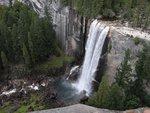Date: August 27, 2012
Park Takes Additional Steps to Protect Public Health
YOSEMITE NATIONAL PARK - The recent diagnosis of hantavirus pulmonary syndrome (HPS) in two Californians, one of whom died, has prompted Yosemite National Park to scale up its public health response and outreach. The National Park Service Office of Public Health learned over the weekend of a confirmed third case, which resulted in a fatality, and probable fourth case, of hantavirus in individuals who visited Yosemite National Park in June of this year. An outreach effort is currently underway by the park concessioner to contact visitors who stayed in "Signature Tent Cabins" at Curry Village from mid-June through the end of August. These individuals are being informed of the recent cases and are being advised to seek immediate medical attention if they exhibit any symptoms of hantavirus.
Hantavirus is a rare but serious disease that occurs throughout the United States. Early medical attention is critical for individuals who contract hantavirus. The disease begins with fever and aches, but can progress rapidly to life-threatening illness. Public health officials believe the four recent visitors might have been exposed while vacationing at Curry Village in Yosemite National Park.
Yosemite National Park has set up a general, non-emergency phone line for all questions and concerns related to hantavirus in Yosemite National Park. The phone number is (209) 372-0822 and it will be staffed from 9:00 a.m. - 5:00 p.m. daily.
"The health of our visitors is our paramount concern and we are making every effort to notify and inform our visitors of any potential illness," said Don Neubacher, Yosemite National Park Superintendent. "Because people often don't get sick from hantavirus until one to six weeks after exposure, we are encouraging anyone who stayed in Curry Village since June to be aware of the symptoms of hantavirus and seek medical attention at the first sign of illness".
The National Park Service Office of Public Health has issued a call for cases to state and local health departments nationwide, and is working with the Centers for Disease Control and Prevention to heighten public health awareness and detection. The park and concessioner have also increased public education efforts geared towards visitors and park employees. This includes distributing information to all visitors entering the park, information at Curry Village registration area, and notifications throughout the park.
California Department of Public Health (CDPH) and Yosemite National Park Public Health Service officers conduct periodic rodent surveys to monitor deer mouse abundance and virus activity in mouse populations. Yosemite National Park has conducted additional rodent trapping and is increasing rodent-proofing and trapping measures in tent cabins and buildings throughout the park. Structures throughout the park continue to be cleaned by following recommended practices and are inspected regularly. Yosemite also conducts routine rodent proofing of buildings and facilities throughout the park.
Since HPS was first identified in 1993, there have been approximately 60 cases in California and 587 cases nationally. About one third of HPS cases identified have been fatal.
HPS is caused by a virus that individuals get through contact with the urine, droppings or saliva of infected rodents, primarily deer mice. Not all deer mice carry hantavirus, but deer mice with hantavirus have been found throughout the United States. Most infections are caused by breathing small particles of mouse urine or droppings that have been stirred up into the air. If the virus is contracted, the symptoms appear one to six weeks after exposure with fever, headache, and muscle ache, and progresses rapidly to severe difficulty in breathing and, in some cases, death.Early medical attention can greatly increase the chance of survival, so it is important to seek medical attention immediately if an individual experiences any of these symptoms and may have been exposed to rodents.
When people are in wilderness areas or places that harbor mice, individuals can take the following steps to prevent HPS:
- Avoid areas, especially indoors, where wild rodents are likely to have been present.
- Keep food in tightly sealed containers and store away from rodents.
- Keep rodents out of buildings by removing stacked wood, rubbish piles, and discarded junk from around homes and sealing any holes where rodents could enter.
- When cleaning asleeping or living area, open windows to air out the areas for at least two hours before entering. Take care not to stir up dust. Wear plastic gloves and spray areas contaminated with rodent droppings and urine with a 10% bleach solution or other household disinfectants and wait at least 15 minutes before cleaning the area. Place the waste in double plastic bags, each tightly sealed, and discard in the trash. Wash hands thoroughly afterward.
- Do not touch or handle live rodents and wear gloves when handling dead rodents. Spray dead rodents with a disinfectant and dispose of in the same way as droppings. Wash hands thoroughly after handling dead rodents.
- If there are large numbers of rodents in a home or other buildings, contact a pest control service to remove them.

 when I read in the above article this quote from park's spokesman, Scott Gideman:
when I read in the above article this quote from park's spokesman, Scott Gideman: )
)
